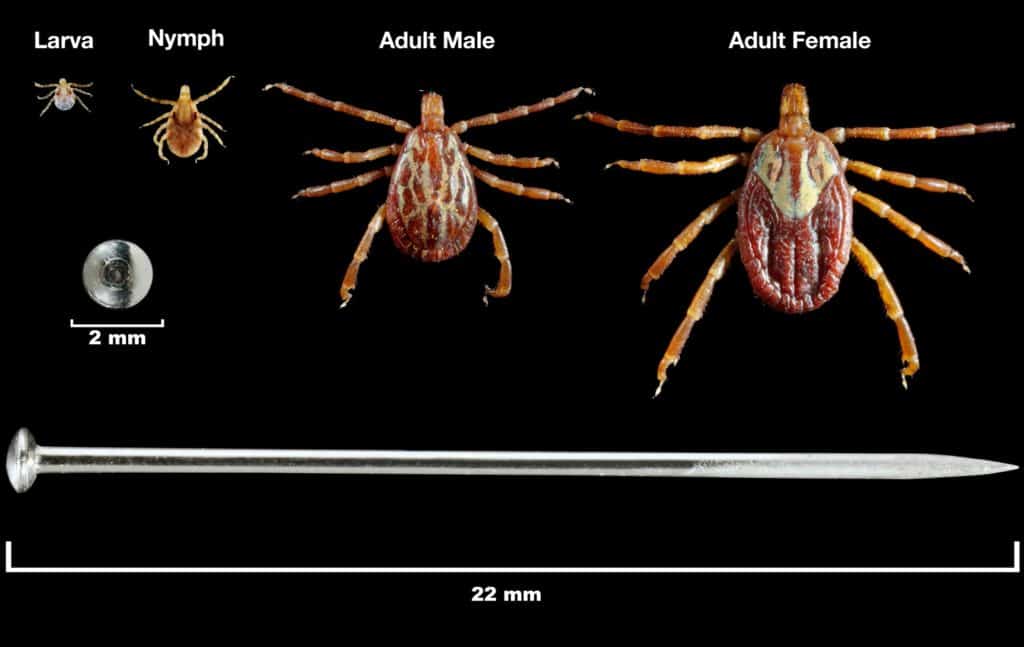Tick-borne diseases are on the rise globally, making it more important than ever to get educated about what attracts ticks to humans, how to avoid contact, and how to detect symptoms of tick-borne illnesses.
What attracts ticks to humans?
Ticks – part of an order of the Arachnid family, which they share with spiders and mites – are external parasites that live on the blood of their hosts. There are four stages of a tick’s lifecycle, and ticks need a blood meal at each one. If they don’t find a host at each new stage, they die.

Image Source: Dr. Christopher Paddock https://phil.cdc.gov/Details.aspx?pid=10879
In other words, ticks need humans (and other animals) to survive. When it comes to what actually attracts ticks to humans, a combination of biological imperatives and chemical clues help ticks seek out, find, and feed on their human hosts.
While humans make great hosts for ticks, they’re not the only animal ticks seek out. Ticks can feed on mammals, birds, reptiles, and even amphibians.
How ticks find their hosts
Ticks live on their hosts’ blood, and humans are a common and convenient host. Conventional wisdom about ticks confirms this: the best tick prevention advice warns people to avoid tick habitats, wear protective clothing and tick repellant if possible, and always check for ticks after possible exposure. Ticks are out there, just waiting to hitch a ride.
But how exactly do they find humans to feed on? Below is a short breakdown of tick behavior.
Sensing hosts
Ticks aren’t very good at seeing shapes, which means they usually can’t tell just by sight that a human is walking around. Instead, ticks use special sensors to detect the carbon dioxide humans breathe out, as well as other human odors. (Research shows that ticks will flock to dry ice – solid carbon dioxide – that has been laid out for them.) Ticks can also track changes in environment, and some can even see shadows.
Questing
When it’s feeding time – generally during summer months, though ticks can strike anywhere at any time – ticks will wait on shrubs or blades of grass and perform an activity called “questing,” in which they cling to the plant with their back two pairs of legs and extend their front pair of legs into the air. When an animal (like a human) brushes past, the ticks will use their front legs to climb on, where they either attach quickly or crawl around to find a suitable spot to feed.
What are the most common feeding spots for ticks?
Ticks prefer to feed in well-hidden areas where the skin is thin enough to puncture easily. This is why the area around the ears is such a common place for ticks to feed on both humans and pets. Since ticks depend on blood to survive, they’ll do what they can to avoid detection, hiding in spots where they’ll be hard to see, like in your hair.
How ticks feed on humans (and transmit diseases)
You won’t feel a bite
Many ticks first secrete saliva with anesthetic properties at the attachment site to numb the area before inserting their feeding tubes. This means you won’t feel the bite, and the tick can live to see another day – and potentially pass on dangerous pathogens – right under your nose.
A germ for a germ
It’s when the tick is attached that the risk of disease presents itself. The exchange of your blood and the tick’s saliva at the attachment site creates an exchange of germs, too. Any pathogens in the host’s blood will be ingested by the tick through the blood meal, and any pathogens they’ve previously ingested can be transferred to the host’s bloodstream through the tick’s saliva. This is what makes them a “vector” for illnesses.
Tick prevention is disease prevention
Ticks are some of the most common vectors for diseases like Lyme disease and Tick-Borne Relapsing Fever (TBRF). As climate change causes warmer global temperatures, tick endemicity is expanding, making the risk of contracting a tick-borne disease even greater. It’s more important than ever to learn about the most common tick-borne illnesses and how to prevent them.
- Avoid tick habitats. While ticks can live anywhere, in any state – including indoors – hotspots include grassy or wooded areas, debris piles, fallen branches, and wood piles or even bird feeders (both of which can attract other tick-feeding wildlife, like rodents). Keep to the center of trails while hiking or camping.
- Protect yourself with long sleeves and pants tucked into socks, light-colored clothing (which can make it easier to spot ticks, which are dark in color), and tick repellant if possible.
- Perform tick checks and shower immediately after possible exposure, such as camping, hiking, or picnicking outdoors.
- Carefully remove any ticks and save them for testing. To have the tick tested at IGeneX, just place the tick (dead or alive) in a small plastic tube or sealed bag, enclose it in an envelope, fill out the Tick Test Request Form, and mail the tick to IGeneX.
- Track symptoms that may indicate tick-borne diseases and talk to your doctor about getting tested for tick-borne illnesses. You can use the IGeneX Symptom Tracker to keep careful track of your symptoms.
To learn more about what to do if you find a tick on you, read What To Do After You’ve Been Bitten By a Tick.
Important: Under no circumstance should you delay treatment. This includes seeing a specialist in tick-borne illness and getting tested with the latest testing technology at a reputable center. The IgXSpot test from IGeneX detects certain tick-borne diseases in their early stages. An accurate diagnosis depends on a careful analysis of your symptoms along with test results; a misdiagnosis can be incredibly costly and dangerous. Learn more about IGeneX testing today.








